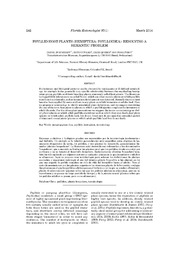Psyllid host-plants (Hemiptera: Psylloidea): resolving a semantic problem.
Psyllid host-plants (Hemiptera: Psylloidea): resolving a semantic problem.
Autoria: BURCKHARDT, D.; OUVRARD, D.; QUEIROZ, D. L. de; PERCY, D.
Resumo: Evolutionary and biological patterns can be obscured by inadequate or ill-defined terminology. An example is the generally very specific relationship between the sap-feeding hemipteran group, psyllids, and their breeding plants, commonly called host-plants. The literature is clogged with references to so called ?hosts?, which are often merely plants on which psyllids were found accidentally, and no immature development was detected. Recently the term host has also been applied by some authors to any plant on which immature or adults feed. Here we propose a terminology to clarify associated plant definitions, and we suggest restricting the use of the term host-plant to plants on which a psyllid species completes its immature to adult life cycle. For the other plant associations we suggest the terms overwintering or shelter plant (plants on which adult psyllids overwinter and on which they may feed), food plant (plants on which adult psyllids feed, but do not breed and do not spend an extended period of time) and casual plant (plants on which adult psyllids land but do not feed).
Ano de publicação: 2014
Tipo de publicação: Artigo de periódico
Unidade: Embrapa Florestas
Palavras-chave: Host-plant, Jumping plant-lice, Planta Hospedeira, Psilídeo, Psyllids, Terminologia, terminology
Observações
1 - Por padrão são exibidas publicações dos últimos 20 anos. Para encontrar publicações mais antigas, configure o filtro ano de publicação, colocando o ano a partir do qual você deseja encontrar publicações. O filtro está na coluna da esquerda na busca acima.
2 - Para ler algumas publicações da Embrapa (apenas as que estão em formato ePub), é necessário ter, no celular ou computador, um desses softwares gratuitos. Sistemas Android: Google Play Livros; IOS: iBooks; Windows e Linux: software Calibre.
Acesse outras publicações
Acesse a Base de Dados da Pesquisa Agropecuária (BDPA) para consultar o acervo completo das bibliotecas da Embrapa.

